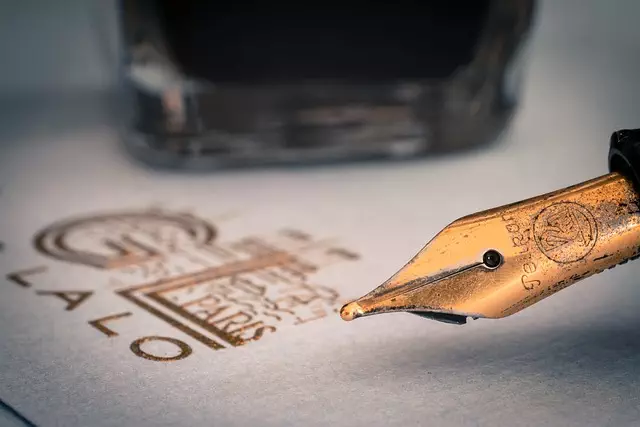Chin augmentation fillers, popular cosmetic procedures, use hyaluronic acid or biocompatible materials to add volume and shape to the chin area, offering immediate results lasting 6-12 months. These non-surgical treatments correct receding chins, enhance aesthetics, and achieve facial balance with minimal downtime and quick recovery. Facial fillers, made from hyaluronic acid or collagen, stimulate natural collagen production for a quick, effective, and long-lasting solution. Popular filler types include HA for shorter durations and PLLA for longer-lasting effects, chosen based on personalized patient needs and goals. Safety considerations include temporary redness, swelling, bruising, and rare complications like asymmetry or infection; choosing a qualified provider minimizes these risks. Post-treatment care involves rest, ice packs, and following healthcare instructions for optimal healing. Filler effectiveness lasts 6-18 months, with regular maintenance treatments recommended. Collaborating with an experienced professional ensures safer, more effective results.
“Enhance your facial aesthetic with chin augmentation fillers – a popular non-surgical procedure gaining traction in the world of cosmetology. This comprehensive guide delves into the intricacies of facial fillers specifically tailored for chin enhancement. From understanding the mechanics behind their effectiveness to exploring various filler types and step-by-step procedures, we demystify this transformative process. Learn about the benefits, potential risks, recovery, and longevity of results. Discover how to make informed decisions when selecting a qualified professional for your journey towards a confident, balanced facial profile.”
Understanding Chin Augmentation Fillers: A Comprehensive Overview

Chin augmentation fillers are a popular cosmetic procedure that involves injecting facial fillers into the chin area to enhance its contour and definition. These fillers, often made from hyaluronic acid or other biocompatible materials, are designed to add volume and shape to the chin, improving facial balance and symmetry.
Understanding chin augmentation fillers starts with recognizing their safety and effectiveness. When administered by a qualified professional, these treatments offer immediate results, lasting for several months to a year. They’re suitable for individuals seeking to correct a receding or weak chin, enhance facial aesthetics, or achieve a more balanced look in line with their overall features. Key benefits include minimal downtime, quick recovery, and the ability to adjust the final result through subsequent treatments.
How Do Facial Fillers Work for Chin Enhancement?

Facial fillers are a popular and effective non-surgical method for enhancing facial features, including the chin. These fillers, typically made from hyaluronic acid or collagen, are injected into the skin to add volume and shape. In the case of chin augmentation, the filler is strategically placed under the skin to lift and define the chin, creating a more prominent and balanced appearance.
The procedure involves a simple injection process, often with minimal discomfort, where the filler is carefully administered to specific points along the chin line. This stimulates the body’s natural collagen production, further enhancing the results over time. With their ability to instantly sculpt and redefine facial contours, facial fillers offer a quick and effective solution for those seeking a more defined chin without the need for surgery.
Benefits and Advantages of Using Chin Fillers

Chin augmentation fillers offer a non-surgical, quick, and effective way to enhance facial features, particularly the chin area. One of the key benefits is their ability to provide instant results, with many patients experiencing a more defined and balanced chin contour just days after treatment. This can significantly improve overall facial harmony and boost confidence.
Additionally, these fillers are highly versatile. They can be used to correct a receding lower face, add structure to a weak chin, or even balance asymmetrical features. The natural-looking results, achieved through the injection of specialized substances that stimulate collagen production, last for several months, making them a popular choice among individuals seeking subtle yet effective enhancements without the downtime associated with surgery.
Types of Fillers Used for Chin Augmentation

When it comes to chin augmentation using fillers, several types are commonly used in dermatological practices today. The choice of filler largely depends on individual patient needs and goals. Facial fillers like hyaluronic acid (HA) are popular for their natural-looking results and ability to enhance facial contours without significant downtime. HA fillers come in various forms, each offering slightly different properties regarding consistency and duration.
Another type is poly-l-lactic acid (PLLA), known for its longer-lasting effects. PLLA fillers provide a more gradual and sustained result compared to HA, making them ideal for patients seeking longer-term solutions. Each filler has unique characteristics, and the selection process involves a thorough consultation between patient and practitioner to determine the best fit based on desired outcomes and individual anatomy.
The Procedure: Step-by-Step Guide to Chin Filler Injections

The procedure for chin augmentation using fillers involves a series of precise steps designed to enhance facial aesthetics. It begins with a consultation where a dermatologist or plastic surgeon assesses the patient’s facial structure and skin quality. This initial step is crucial in determining the amount and type of filler needed, ensuring natural-looking results. During the actual treatment, a topical anaesthetic may be applied to minimize discomfort. The provider then injects the filler into specific points along the chin, following anatomical landmarks to achieve symmetry.
The filler used, often a hyaluronic acid-based product, is carefully selected based on its compatibility and desired effects. Once injected, the area is gently massaged to ensure even distribution of the product. Patients can usually resume normal activities immediately after the procedure, though mild swelling or bruising may occur temporarily. This step-by-step guide highlights the meticulous approach to chin augmentation fillers, ensuring patients achieve their desired aesthetic goals with minimal downtime.
Safety and Potential Risks Associated with Chin Filler Treatments

Chin augmentation fillers, like all facial fillers, come with their own set of safety considerations and potential risks. The most common side effects include temporary redness, swelling, bruising, and discomfort at the injection site. These usually subside within a few days to a week. More serious but rare complications may include asymmetry, infection, hematoma (bleeding), or an allergic reaction to the filler. It’s crucial to choose a qualified and experienced provider who uses sterile techniques and certified products to minimise these risks.
Before undergoing any chin filler treatment, it’s important to discuss your medical history, expectations, and concerns openly with your provider. They may recommend avoiding certain medications that can increase bleeding risk, and they’ll guide you on post-treatment care. Regular follow-ups are also essential to ensure the best results and address any unforeseen issues promptly.
Recovery and Aftercare Following Chin Filler Procedures

Recovery and aftercare play a significant role in the overall outcome of chin augmentation filler procedures. Following the treatment, it’s common to experience some redness, swelling, and mild discomfort in the treated area. Patients are usually advised to take it easy for the first 24 hours, avoiding strenuous activities or exercises that may increase blood flow to the face. Applying ice packs can help reduce swelling and provide temporary relief from any post-procedure discomfort.
The skin on the chin and jawline might feel a bit tender and appear slightly bruised immediately after the procedure, but these symptoms typically subside within a few days. It’s essential to follow your dermatologist or medical professional’s instructions regarding cleaning and caring for the treated area. Gentle cleansing and avoiding harsh products can ensure optimal healing. Additionally, staying hydrated, getting enough rest, and maintaining a healthy diet will contribute to a smoother recovery process for facial fillers like chin augmentation treatments.
Longevity and Maintenance of Results: What to Expect

The longevity of chin augmentation fillers can vary depending on several factors, including the type of filler used and individual anatomy. On average, results from this cosmetic procedure can last anywhere from 6 to 18 months. Hyaluronic acid-based fillers, a popular choice for facial fillers, generally break down over time as the body reabsorbs the material. This gradual absorption allows for natural-looking results that fade rather than disappear abruptly.
Regular maintenance treatments are often recommended to maintain the desired contour and definition. During these touch-up sessions, a smaller amount of filler can be reinjected to replenish volume loss and restore the initial look. With consistent care, patients can enjoy prolonged enhancements, ensuring their chins remain augmented and well-defined for extended periods without significant changes in appearance.
Finding the Right Professional for Your Chin Augmentation Journey

Starting your chin augmentation journey requires finding a qualified professional who understands facial fillers and their application. It’s crucial to look for an experienced aesthetic practitioner or dermatologist who can offer expert advice tailored to your specific needs. Many reputable professionals will begin with a consultation, assessing your facial structure, skin type, and goals to determine if chin fillers are the right choice. They’ll also discuss different filler types, their benefits, potential risks, and long-term outcomes.
During this process, ask about their training, certifications, and the brands of fillers they use. A good practitioner will make you feel at ease, answer your questions honestly, and provide before-and-after examples to help you visualize the potential results. Remember, finding the right professional ensures a safer and more effective chin augmentation experience with minimal side effects.
